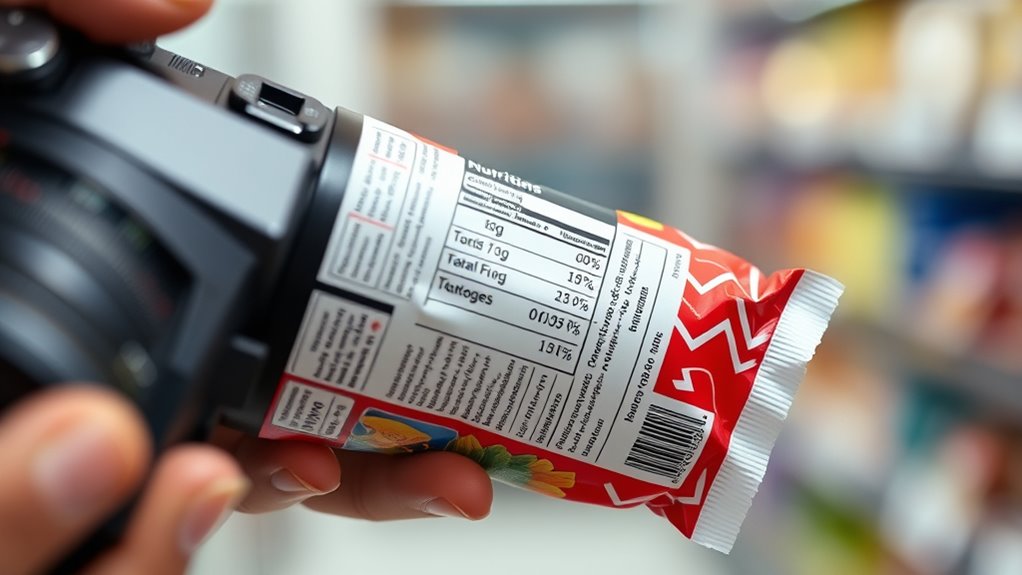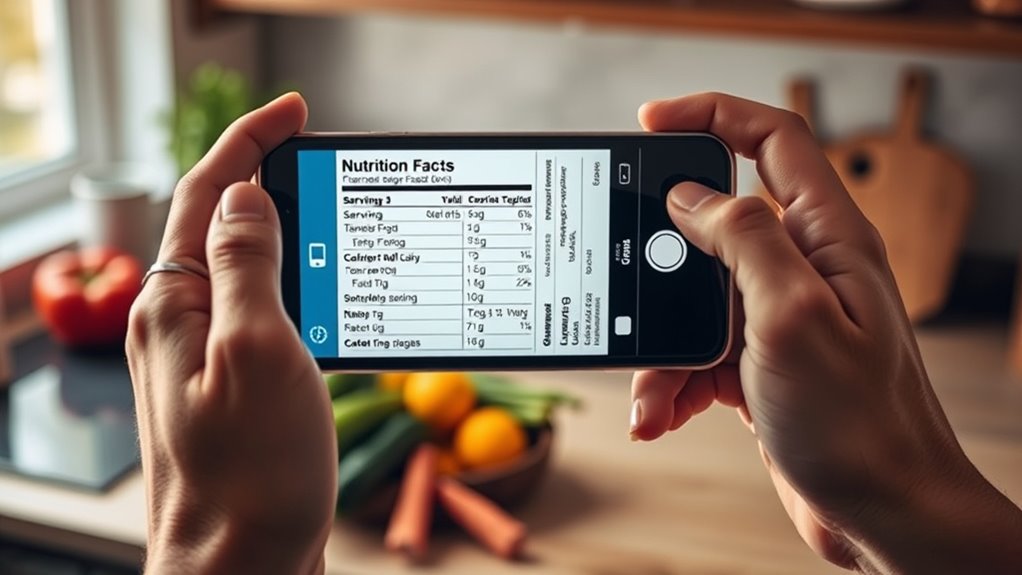To analyze a nutrition label like a clinical dietitian, start by checking the ingredient list for simplicity and potential allergens. Pay attention to serving sizes and compare them to actual portions you eat. Focus on nutrient density by evaluating calories, fats, sodium, and added sugars, aiming for options high in fiber and protein. Be precise with portion adjustments for accurate tracking. Keep exploring to discover more ways to make the best choices for your health.
Key Takeaways
- Review the ingredient list for allergens, additives, and overall ingredient quality, noting shorter lists for less processed foods.
- Check the serving size and adjust nutritional info accordingly to accurately track intake and compare products.
- Focus on nutrient density by evaluating calories, fats, sodium, added sugars, fiber, and protein per serving.
- Assess the clarity of the label, including serving size accuracy, to ensure consistent understanding and healthy choices.
- Interpret the nutrition facts panel holistically, prioritizing minimally processed foods with balanced macro- and micronutrient profiles.

Understanding how to read a nutrition label is essential for making healthier food choices. When you pick up a packaged food item, your first step should be to examine the ingredient list. This list reveals what’s actually in the product, helping you identify potential allergens, additives, and the quality of ingredients used. A shorter ingredient list usually indicates a simpler, less processed product, while longer lists with unfamiliar ingredients might signal more preservatives or fillers. Pay attention to the order of ingredients—those listed first are present in the largest amounts. If you see added sugars, unhealthy fats, or artificial ingredients near the top, it’s a sign to consider a different option. Understanding the ingredient list empowers you to make more informed decisions aligned with your health goals.
Next, you need to check the serving size. The nutrition facts are based on this specific amount, so it’s crucial to compare it to the portion you actually plan to eat. For example, if the label states one serving is half a cup, but you’re pouring a full cup, you’re consuming double the calories, sugars, and fats listed. Many people overlook this detail, leading to misjudging how much they’re actually eating. Always adjust the nutrition information accordingly if your portion differs from the listed serving size. This step guarantees you’re accurately tracking your intake, especially if you’re monitoring calories, macronutrients, or specific nutrients like sodium or fiber. Additionally, understanding label clarity can help you recognize which products communicate nutritional information more effectively, aiding your decision-making process. Being aware of serving size accuracy can further support consistent tracking and healthier choices.
Furthermore, paying attention to the nutrient density of a product can help you choose options that offer more nutritional value per calorie, supporting your overall health goals. Once you’ve checked these basics, focus on the nutrition facts panel itself. Look at the calories per serving to gauge how energy-dense the food is. Then, evaluate the amounts of fat, saturated fat, trans fats, cholesterol, sodium, carbohydrates, sugars, fiber, and protein. Aim for foods that are lower in added sugars, unhealthy fats, and sodium, and higher in fiber and protein. These components influence your overall health and help you meet your dietary needs. Remember, serving sizes are just a guide; your actual portions might be larger or smaller, so always do the math to keep your intake on track. Additionally, understanding contrast ratio can help you select products with better visual appeal and clarity, which may influence your perception of quality and freshness.
Frequently Asked Questions
How Accurate Are Nutrition Labels Compared to Actual Food Content?
Nutrition labels offer a good general guide but aren’t perfectly precise, mainly due to ingredient variability and label precision limits. You might find small differences between listed values and actual food content because natural ingredients vary and manufacturing processes can cause minor deviations. While labels are helpful for making healthier choices, remember they provide estimates, not exact measurements. Always consider these factors, especially if you track intake closely for health reasons.
Can Nutrition Labels Help Identify Added Sugars?
Nutrition labels can help you spot added sugars, including natural sweeteners and sugar substitutes. Look at the ingredient list for terms like honey, agave, or cane syrup, which are natural sweeteners, or artificial options like aspartame or sucralose. Check the “Total Sugars” and “Added Sugars” lines to understand how much sugar has been added versus naturally occurring. This makes it easier to manage your intake and choose healthier options.
How Do Serving Sizes on Labels Affect Dietary Choices?
Think of serving sizes as your personal compass, guiding your portion control and label literacy. When you understand these sizes, you can better judge how much you’re truly consuming, avoiding hidden excess calories or nutrients. Accurate serving sizes help you make informed dietary choices, preventing overeating and fostering healthier habits. By mastering this symbol, you empower yourself to navigate food labels confidently and maintain a balanced, mindful diet.
Are Organic or Non-Gmo Labels Related to Nutrition Content?
You might wonder if organic claims or non-GMO labeling impact nutrition content. While these labels indicate farming practices and ingredient sourcing, they don’t necessarily mean the food is more nutritious. Organic claims focus on how food is grown, and non-GMO labeling highlights ingredient origins. So, don’t assume they’re healthier; always check the nutrition facts to understand the actual nutritional content of your food.
What Should I Consider for Special Dietary Needs Beyond Labels?
Imagine you’re steering a grocery aisle—think of it as your own version of a digital age adventure. When considering special dietary needs, focus on allergy considerations and gluten sensitivities. Always check ingredient lists and allergen statements carefully. If labels aren’t clear, consult with a healthcare professional or look for certified gluten-free or allergy-friendly symbols. This way, you guarantee your choices align with your health requirements beyond just reading the nutrition label.
Conclusion
Now that you know the secrets behind nutrition labels, you’re ready to make smarter choices. But remember, the real challenge is applying this knowledge every day. Will you look past the tempting front and uncover hidden sugars or fats? The next time you shop, will you take a moment to decode those numbers and make a truly informed decision? Your health could depend on it—so are you ready to see what’s really behind that label?










